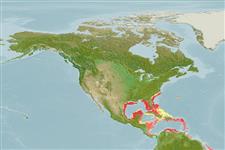>
Anguilliformes (Eels and morays) >
Ophichthidae (Snake eels) > Ophichthinae
Eponymy: In Greek mythology Gordias was a farmer who, by fulfilling an oracle, became King of Phrygia (in modern Turkey). [...] (Ref. 128868), visit book page.
More on authors: McCosker, Böhlke & Böhlke.
Environment: milieu / climate zone / depth range / distribution range
Écologie
marin démersal; profondeur 10 - 189 m (Ref. 43688). Temperate
Western Central Atlantic: northeast Gulf of Mexico.
Taille / Poids / Âge
Maturity: Lm ? range ? - ? cm
Rarest species of the genus; known only from the holotype (Ref. 43688).
Life cycle and mating behavior
Maturité | Reproduction | Frai | Œufs | Fécondité | Larves
McCosker, J.E. and R.J. Lavenberg, 2001. Gordiichthys combibus, a new species of eastern Pacific sand-eel (Anguilliformes: Ophichthidae). Rev. Biol. Trop. 49(Suppl. 1):7-12. (Ref. 43688)
Statut dans la liste rouge de l'IUCN (Ref. 130435: Version 2024-2)
Menace pour l'homme
Harmless
Utilisations par l'homme
Outils
Articles particuliers
Télécharger en XML
Sources Internet
Estimates based on models
Preferred temperature (Ref.
123201): 21 - 27.4, mean 24.7 °C (based on 88 cells).
Phylogenetic diversity index (Ref.
82804): PD
50 = 0.5312 [Uniqueness, from 0.5 = low to 2.0 = high].
Bayesian length-weight: a=0.00091 (0.00039 - 0.00215), b=2.99 (2.79 - 3.19), in cm total length, based on LWR estimates for this (Sub)family-body shape (Ref.
93245).
Niveau trophique (Ref.
69278): 3.8 ±0.6 se; based on size and trophs of closest relatives
Résilience (Ref.
120179): Milieu, temps minimum de doublement de population : 1,4 à 4,4 années (Preliminary K or Fecundity.).
Fishing Vulnerability (Ref.
59153): Moderate vulnerability (43 of 100).
